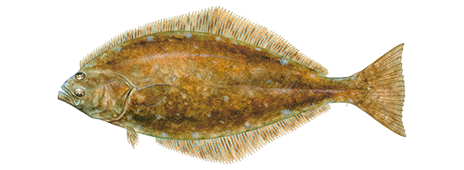Atlantic Halibut

The Atlantic halibut is among the largest bony fishes in the Atlantic Ocean.
HOW TO IDENTIFY AN ATLANTIC HALIBUT
The underside is usually pearly white and featureless but some specimens have a reddish tint on their underside giving them the nickname, “cherry bellies”. The lateral line, which has a scale count of about 160 scales, is straight for most of its length but curves high over the pectoral fin. The huge mouth is very well equipped to feed on anything that it can fit into its mouth and the teeth are curved. Although catches have been reported to more than 500 lbs in the past, the largest halibut of recent times have been in the 200-300 lb range. Typically, the average weight of an Atlantic halibut is from 50-150 lbs. Halibut weighing 350 lbs are about 7-8 feet long and 4 feet wide making them a challenging fish for anglers.
WHERE TO CATCH ATLANTIC HALIBUT
The Atlantic halibut inhabits cold and boreal waters of the North Atlantic, including the Barents Sea, Iceland, and Greenland. It is also found in very deep, cold waters as far south as Virginia on the American side and southwest Ireland on the European side of the Atlantic Ocean. This species does not occur in near freezing polar waters as many people believe, but is replaced in these waters by the Greenland halibut. The following list includes additional details on where to catch this fish:
Rocky Sea Floor
HOW TO CATCH ATLANTIC HALIBUT
Atlantic halibut feed on the bottom of the seafloor as well as at midwater depths. The best fishing method is drift fishing on the bottom with heavy tackle and natural dead baits such as clams, squid, and other shellfish. Halibut of all varieties are very formidable opponents for anglers. They are very difficult to bring up from the bottom and even at the surface they remain full of fight and must be handled carefully. When boating a large halibut, be sure the fish is tired out and that the fish is not free to flap around the deck of a boat. Many anglers have found out the hard way that a halibut’s body and tail can break anything they come in contact with. The following are fishing methods used to catch this fish:
Drift Fishing Bottom Bouncing Saltwater Jigging